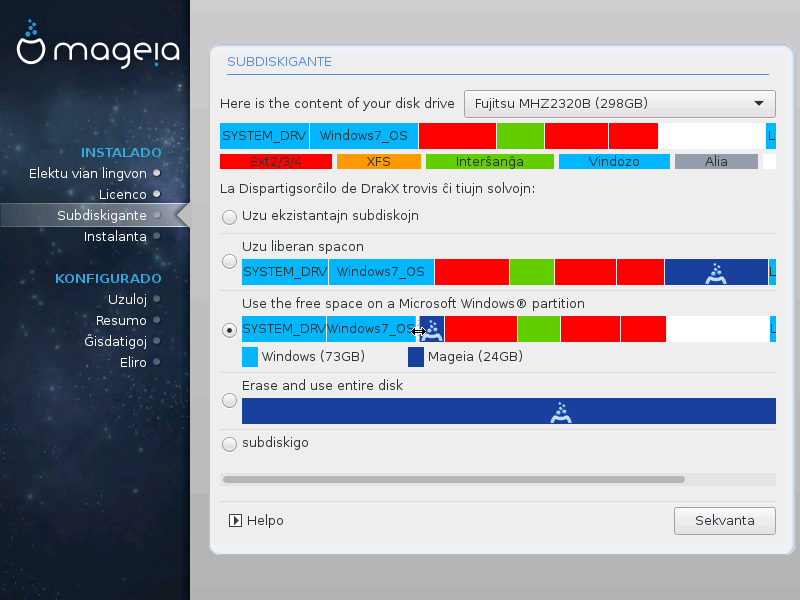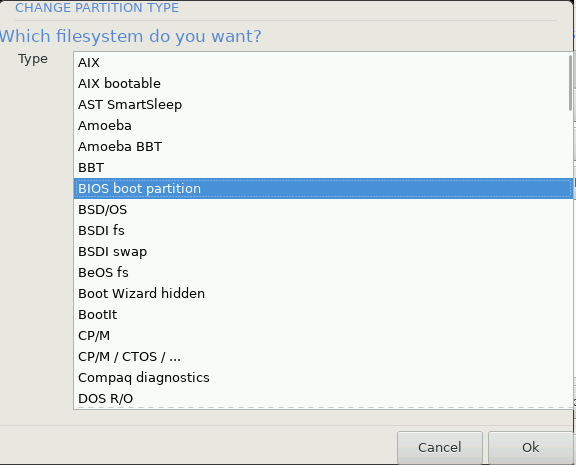En tiu ĉi ekrano vi povas vidi la enhavon de via(j) stor-aparato(j) kaj la loko-proponon de DrakX por la instalo de Magejo.
La disponeblaj elektoj en la suba listo varios depende de la trajtoj kaj enhavo de via konkreta(j) stor-aparato(j).

Se tiu elekto estas disponebla oni trovis linuks-akordigeblajn subdiskojn kiuj povas esti utiligataj por la instalo.
Se vi havas neuzitan spacon en via fiksita disko ĉi tiu elekto uzos ĝin por nova Mageja instalo.
Uzu la liberan spacon de vindoza subdisko
Se vi havas neuzitan spacon en ekzistanta vindoza subdisko, la instalilo povas proponi utiligi ĝin.
Ĉi tio povas esti utila maniero atingi spacon por via nova Mageja instalo, sed temas pri riska operacio do vi devus fari sekurec-kopion de ĉiuj gravaj dosieroj antaŭe!
Rimarku ke ĉi tio implikas la ŝrumpigon de la vindoza subdisko. La subdisko devas esti "pura", tio estas Vindozo devis fermiĝi senprobleme la lastan fojon kiam ĝi estis uzita. Ĝi ankaŭ devas esti malfragmentiĝita kvankam tio ne estas garantio pri tio ke ĉiuj dosieroj en la subdisko estis movitaj el la areo uzota. Estas ege rekomendinde realigi sekurec-kopion de viaj personaj dosieroj.
With this option, the installer displays the remaining Windows partition in light blue and the future Mageia partition in dark blue with their intended sizes just under. You have the possibility to adapt these sizes by clicking and dragging the gap between both partitions. See the screen-shot below.

Partitions sizing:
The installer will share the available place out according to the following rules:
If the total available place is lower than 50 GB, only one partition is created for /, there is no separate partition for /home.
If the total available place is over 50 GB, then three partitions are created
6/19 of the total available place is allocated to / with a maximum of 50 GB
1/19 is allocated to swap with a maximum of 4 GB
the rest (at least 12/19) is allocated to /home
That means that from 160 GB and over of available place, the installer will create three partitions: 50 GB for /, 4 GB for swap and the rest for /home.
Rimarko
If you are using an UEFI system, the ESP (EFI System Partition) will be automatically detected, or created if it does not exist yet, and mounted on /boot/EFI. The "Custom" option is the only one that allows to check it has been correctly done
Rimarko
If you are using a Legacy (as known as CSM or BIOS) system with a GPT disk, you need to create a Bios boot partition if not already existing. It is an about 1 MiB partition with no mount point. Choose the "Custom disk partitioning" option to be able to create it with the Installer like any other partition, just select BIOS boot partition as filesystem type.


Averto
Some newer drives are now using 4096 byte logical sectors, instead of the previous standard of 512 byte logical sectors. Due to lack of available hardware, the partitioning tool used in the installer has not been tested with such a drive. Also some ssd drives now use an erase block size over 1 MB. We suggest to pre-partition the drive, using an alternative partitioning tool like gparted, if you own such a device, and to use the following settings:
"Align to" "MiB"
"Free space preceding (MiB)" "2"
Also make sure all partitions are created with an even number of megabytes.


